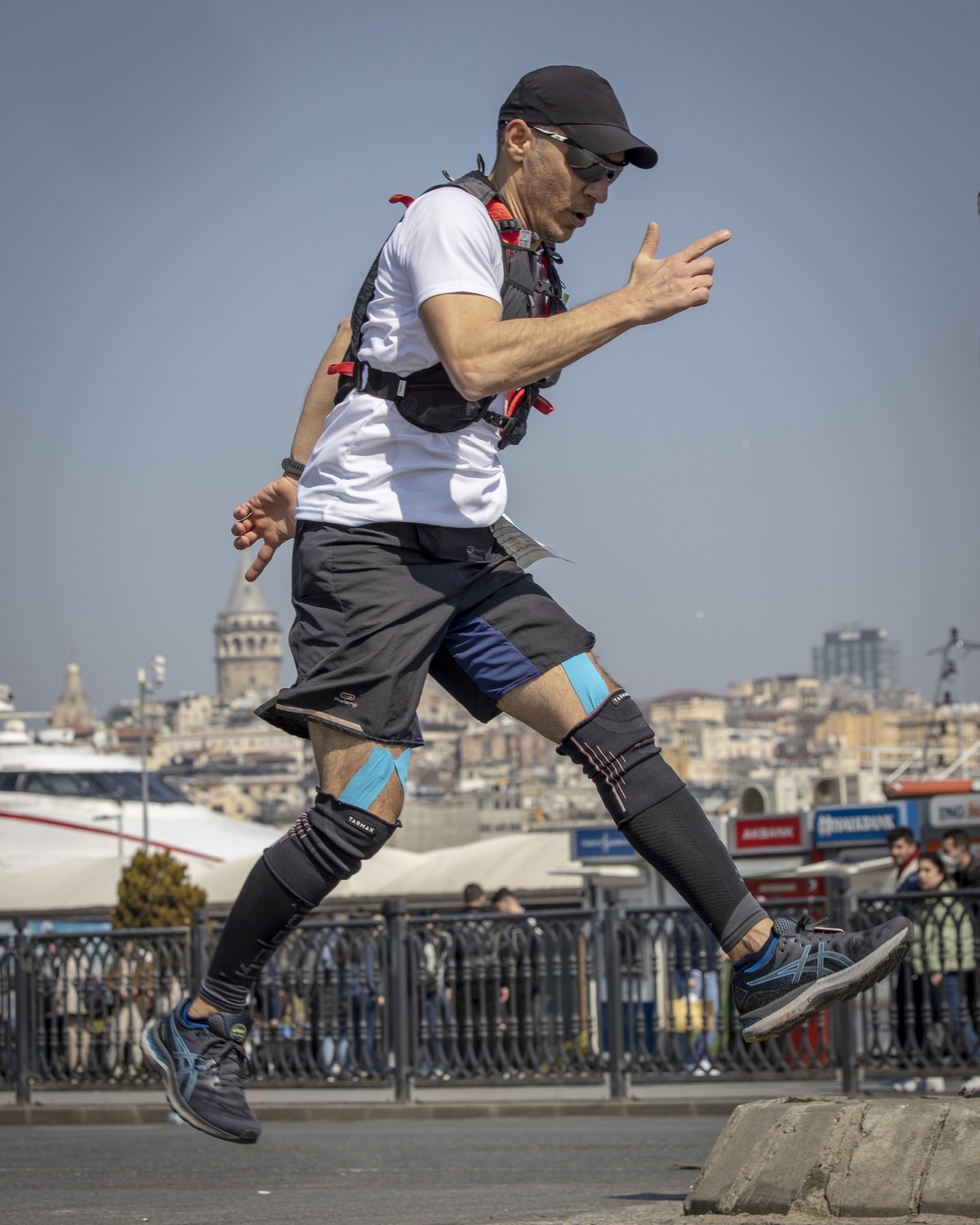For many people, running a marathon distance of 42,195 meters is a personal goal. Maybe you want to see your own limits, maybe you want to run a marathon distance to prove yourself that you can complete it. However, the marathon is a serious distance. You need months of physical and mental preparation consciously. It’s a good idea to run regularly at least for a year before your first marathon to minimize potential problems.
Beginning
Be aware of yourself: Millions of people around the world run marathon each year. However, trying to run this distance without adequate preparation can result in health problems. For this reason, before running a marathon, consult your doctor to make sure that you do not have a health problem that will prevent you from running. In the preparation phase, if you start from short distances and progress gradually, you can make a safer improvement without any problems.
Patience and persistence: Running is inherently an impact sport, and most injuries result from rapidly increasing distances. You should increase the intensity of training gradually so that your body adapts to the workouts. Focusing on distances such as 5K, 10K and then 21K will prepare you physically for the marathon distance and reduce the risk of injury.
Start early: In general, before you start preparing for a marathon, your body needs to be ready for it. If you can run a total of 30-40 km per week on a regular basis, you may think that you are ready for marathon training.
Getting to Know Your Marathon
Thousands of marathons are organized around the world each year. Although they all have the same distance, they can have very different characteristics from each other. Before starting a marathon preparation, you should consider many features such as the air temperature, the characteristics of the racecourse, and how crowded the race is. Also, considering that it will take at least 3 to 4 months to get prepared for the marathon, you should make sure that you are ready both physically and mentally.
At this point, it would be right to choose a race that is close to the characteristics of the region you are training in. For example, if you have to do your preperation in very cold weather, choosing a marathon run in very hot weather may not be suitable for you. It is aimed that the Istanbul Half Marathon is planned in April and the İstanbul Marathon in November under average climatic conditions. It is aimed that there would not be extreme diffences between prepation and running conditions to minimize race-related health problems in Istanbul Maraton.
The Tips of Marathon Training
Marathon preparation training can be grouped under five main headings:
- 1. Weekly Distance: Gradually increase your total weekly distance. Your starting distance will be estimated according to your background, fitness, weight and current training status. For your first marathon preparation, you can run 3 to 5 days a week.
- Long Run: Long runs, which you could perform on weekends, prepare you physically and mentally for the marathon distance.
- Speed Workouts: Interval, tempo and/or HIIT runs increase your endurance capacity and allow you to run longer at a certain speed.
- Rest and Recovery: Leaving enough rest days in training programs protects you from injuries. In addition, adaptations in the body occur during rest.
- 5. Nutrition: Proper nutrition is an important parameter that affects both your training performance and recovery. Calculating your daily calorie needs on training and non-training days and knowing how much of these calories you will get from protein, fat and carbohydrates respectively will optimize both your performance and your recovery level. In addition to nutrition, it is important to pay attention to adequate fluid intake and avoid excessive hydration.
Weekly Distance
Many marathon preparation programs last between 12 and 20 weeks. Those who run their first marathon can plan to gradually increase their total weekly distance to 70-80 km in 4 months before the marathon.
In general, running 3 to 5 times a week will be sufficient. Most of these runs should be run at a pace you can chat during running. While increasing your weekly distance, be careful about not to increase it more than 10 percent compared to the previous week so that your body can easily adapt.
Long Run
You usually prepare your body for the distance with long runs on weekends. You can extend your distance a few kilometers each week, but it is advised to allow your body to recover by running a shorter distance in every three weeks. These runs at a comfortable pace not only strengthen you physically, but also increase your self-confidence and adjust your body to use fat for energy.
In most marathon training programs, the longest run does not exceed 32 km. Running longer increases your recovery time and increases your risk of injury. Although you reduce the training level and enter the race rested in the last few weeks, you cannot complete the remaining distance in your marathon with the effect of the race motivation.

Short-Term High-Intensity Running
Trainings such as HIIT (High Intensity Interval Training), Interval and Tempo increase your aerobic and anaerobic endurance capacity. Thus, you start to maintain a certain speed for a longer time and you start to run the same distance in a shorter time. The underlying physiological reason for this is that this type of training improves the body’s lactate tolerance by improving the anaerobic threshold.
High-intensity interval training, known as HIIT, is recognized as a very effective method for increasing cardiovascular fitness for both beginners and people with a training background. Results from studies show statistically significant benefits to cardiovascular fitness and muscle development. It provides efficient development of cardiorespiratory and metabolic function in terms of time. You should be at about 80-90% of your maximum heart rate while doing HIIT cardio. If you don’t have a heart rate monitor, you can determine the rate of perceived exertion (RPE). The RPE value is a scale between 1 and 10 that determines the intensity of physical activity. 1 means you don’t make any effort and you feel comfortable, 10 means you can’t do more repetitions too intense. For an effective HIIT workout, you should aim for an effort level of around 8-9 out of 10.
Tempo runs are usually 20 to 40 minutes long. You run these at a pace that challenges you to a certain extent but is not like a race. These workouts prepare your body to maintain your pace for longer periods of time.
In interval training, after running fast for short distances, you rest for a while by walking or jogging. You can repeat this a certain number of times. These workouts are usually at distances such as 400-800-1000-1600 meters. For example, after running 800 meters in 4 minutes, you can rest for 2-3 minutes by walking or jogging and repeat this 6 times. When planning your training, having a heart rate monitor, determining your anaerobic threshold before training, and planning your training according to your maximal heart rate will contribute to your training efforts.
Rest and Recovery
Since you don’t run on rest days, you can have both physical and mental recovery. The biggest risk for someone preparing for a marathon is to get injured, and the best way to reduce the risk of injury is to have rest days. You may want to consider adding rest days, especially after long runs and speed training.
If you want to do another activity on your rest days, you can choose non-impact activities such as swimming, cycling, yoga, walking, provided that you perform them at low intensities.
In the 2nd to 3rd weeks before the marathon, it is recommended to gradually reduce your weekly distance and rest before the race day. Rest and quality sleep are more important than long workouts, especially in the few days before the marathon. The day before the race, depending on your travel condition and tiredness, you may consider either resting completely or doing a light sweat run for a few kilometers.
Nutrition
Adequate and balanced nutrition is the primary condition of a good training plan. Nutrition is a factor that can be ignored, but is related to performance as a great extent. In the proceses of marathon preparation, planning your nutrition before, after and during training is important as well as planning your training itself. You first need to shape your nutrition program according to your calorie needs. However, it is important to eat by estimating your daily requirements for protein, carbohydrate and fat. Studies have shown that the daily protein requirement for runners should be between 1.4 and 1.6 grams per kilogram, although it varies according to various factors. It is recommended that the amount of carbohydrates to be taken daily should be 4.8 – 5 grams per kilogram. Most of the consumed carbohydrates should be from complex carbohydrates. Simple carbohydrates should be avoided as much as possible, especially before training. Adequate consumption of vitamins and minerals, and adequate fluid intake are also important factors in running performance and recovery.

Mental Preparation
Although physical training plays an important role in marathon preparation, many people will emphasize the importance of mental preparation when you talk to people who have run a marathon before. In endurance sports, your mind often gives up first and makes you believe that you can’t succeed by engaging negative thoughts, even though you actually have more strength. The way to reverse this is to strengthen your mind, just like your muscles.
For example, some days you may be lack of motivation and you may not want to train. If you don’t have a valid reason not to do it, showing the perseverance to start training in such situations strengthens you mentally. You can think of it as a brick added to a building you build every day.
On the other hand, bad weather conditions will force you in some days. However, these are very important opportunities to get to know yourself and learn something new. For example, if you are afraid of running in the rain, you should motivate yourself to run on rainy days. Once you learn how to dress, you can teach your mind how to deal with rain during running. The same is valid for hot, cold or windy weather. You cannot control the weather conditions on race day, but if you prepare yourself mentally for all types of conditions during the training, nothing will be surprise for you in the race.
Another technique is the imagination technique. You can run as if you are actually racing by imagining the race you will participate in in a quiet and calm environment. For this, the first 10-15 minutes after waking up is a good time frame. You think about the problems you may experience in the race and plan how you can react to them and produce solutions. Thus, when you encounter these problems during the race, it will be clear what you will do.
One of the most used techniques by runners is to set a mantra/slogan for themselves. It could be something about yourself, or an important person or event for you. For example, you can repeat words such as “everyone would do it if it was easy”, “I will succeed”, “I have worked for months, I am ready.” when you find it difficult. For example, when you reach the 30th km and start to get more difficult, you can also motivate yourself again by saying “The race starts now.”.
Some runners write them down in places where they can be easily seen while running in the race, such as their hands or arms, to remember. On the other hand, if you apply these in your long training sessions, you will start doing it without thinking in the race. Remember that when you are running a long distance like a marathon, your mind can be your greatest friend as well as your worst enemy.
Prof. Dr. Mutlu Vural
Health Director of Istanbul Marathon
Acknowledgements: These informative texts were prepared with the consultation of sports medicine Professor Bülent Bayraktar and ultramarathon runner Aykut Kocabaş.





